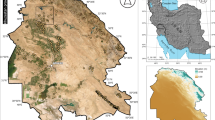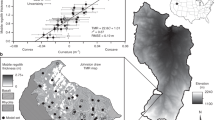Abstract
This study focuses on the multiscale calculation of different plan curvature forms to enhance the modeling of soil penetration resistance and gravimetric soil water content utilizing the classification and regression trees algorithm in a low-relief watershed. To that end, three forms of plan curvature were derived using the Wood method from a two-meter digital elevation model on six neighborhood sizes. The results showed that the neighborhood size influenced the plan curvature values and there was little difference between the utilization of three forms of plan curvature in the landform determination. The modeling results indicated that the three forms of plan curvature on most neighborhood scales have different contributions to each other in modeling the spatial variability of each soil property. The neighborhood scale was a critical factor in soil modeling because it controls the smoothing rate of plan curvature. The overall results suggest that soil models with poor performance could be constructed if the plan curvature forms and the neighborhood size are not considered in the geomorphometric analysis. Therefore, it is recommended to use the procedure implemented in this study for digital soil mapping in various regions.







Similar content being viewed by others
Data availability
The data that support the findings of this study are available from the corresponding author upon reasonable request.
References
Albani M, Klinkenberg B, Andison DW, Kimmins JP (2004) The choice of window size in approximating topographic surfaces from digital elevation models. Int J Geogr Inf Sci 18(6):577–593
Amundson R (2006) The state factor theory of soil formation. In: Certini G, Scalenghe R (eds) Soils: basic concepts and future challenges. Cambridge University Press, Cambridge, pp 103–112
Ayobi SH, Alizadeh MH (2006) Soil surface attributes prediction using digital topographic model in mehr catchment, Sabzevar, Khorasan Province. J Water Soil Sci 10(2):85–97
Bayat H, Sheklabadi M, Moradhaseli M, Ebrahimi E (2017) Effects of slope aspect, grazing, and sampling position on the soil penetration resistance curve. Geoderma 303:150–164
Evans IS (1979) Statistical characterization of altitude matrices by computer. An integrated system of terrain analysis and slope mapping. The final report on grant DA-ERO-591–73-G0040. Durham, UK: University of Durham
Florinsky I (2016) Digital terrain analysis in soil science and geology, 2nd edn. Academic Press, Amsterdam
Jakšík O, Kodešová R, Kubiš A, Stehlíková I, Drábek O, Kapička A (2015) Soil aggregate stability within morphologically diverse areas. CATENA 127:287–299. https://doi.org/10.1016/j.catena.2015.01.010
Jenčo M (1992) The morphometric analysis of georelief in terms of a theoretical conception of the complex digital model of georelief. Acta Fac Rerum Nat Univ Comen Geogr 33:133–151
Jenny H (1941) Factors of soil formation: a system of quantitative pedology. McGraw-Hill, New York
Khanifar J, Khademalrasoul A (2020a) Multiscale comparison of LS factor calculation methods based on different flow direction algorithms in Susa Ancient landscape. Acta Geophys 68(3):783–793. https://doi.org/10.1007/s11600-020-00432-1
Khanifar J, Khademalrasoul A (2020b) The relationship between bedrock geometry and soil solum at a regional scale. In: Proceedings of the geomorphometry 2020b conference, Perugia, Italy (pp 135–138)
Khanifar J, Khademalrasoul A, Amerikhah H (2020a) Effects of digital elevation model (DEM) spatial resolution on soil landscape analysis (Case study Raakat watershed of Izeh, Khuzestan Province). Appl Soil Res 8(1):121–135
Khanifar J, Khademalrasoul A, Amerikhah H (2020b) Modelling of soil aggregate stability as an index of soil erodibility using geomorphometric parameters. J Agric Eng Soil Sci Agric Mech (Sci J Agric) 43(1):45–60
Khanifar J, Khademalrasoul A (2021) Effects of neighborhood analysis window forms and derivative algorithms on the soil aggregate stability–Landscape modeling. CATENA 198:105071. https://doi.org/10.1016/j.catena.2020.105071
Khanifar J, Khademalrasoul A (2022a) Utilization of multi-scale geomorphometric algorithms and third-order morphometric variables for soil thickness modeling. Trans GIS 00:1–15. https://doi.org/10.1111/tgis.12891
Khanifar J, Khademalrasoul A (2022b) Effect of neighborhood-size on morphometric variables and their relationship with vegetation cover within three geomorphologically and climatically different sub-watersheds in southwest Iran. Iran J Soil Water Res. https://doi.org/10.22059/ijswr.2022.334244.669136
Lam NSN (2019) Resolution. In: Wilson JP (Ed.), The geographic information science & technology body of knowledge (2nd Quarter 2019 Edition). https://doi.org/10.22224/gistbok/2019.2.11
Maynard JJ, Johnson MG (2014) Scale-dependency of LiDAR derived terrain attributes in quantitative soillandscape modeling: effects of grid resolution vs. neighborhood extent. Geoderma 230:29–40. https://doi.org/10.1016/j.geoderma.2014.03.021
Minár J, Evans IS, Jenčo M (2020) A comprehensive system of definitions of land surface (topographic) curvatures, with implications for their application in geoscience modelling and prediction. Earth-Sci Rev 211:103414. https://doi.org/10.1016/j.earscirev.2020.103414
Neisi H, Khademalrasoul A, Amerikhah H (2021) Mapping of water erosion and deposition affected by different LS algorithms using WaTEM/SEDEM model. Water Soil 35(1):67–82. https://doi.org/10.22067/jsw.2020.14940.0
Olaya V (2009) Basic land-surface parameters. In: Hengle T, Reuter HI (eds) Geomorphometry: concepts, software, applications. Elsevier, Amsterdam, pp 141–169
Rana S (2006) Use of Plan curvature variations for the identification of ridges and channels on DEM. In: Riedl A, Kainz W, Elmes GA (eds) Progress in spatial data handling. Springer, Berlin, Heidelber, pp 789–804
Rigol-Sanchez JP, Stuart N, Pulido-Bosch A (2015) ArcGeomorphometry: a toolbox for geomorphometric characterisation of DEMs in the ArcGIS environment. Comput Geosci 85:155–163. https://doi.org/10.1016/j.cageo.2015.09.020
Roecker SM, Thompson JA (2010) Scale effects on terrain attribute calculation and their use as environmental covariates for digital soil mapping. In: Boettinger JL, Howell DW, Moore AC, Hartemink AE, Kienast-Brown S (eds) Digital soil mapping: Bridging research, environmental application, and operation. Springer, Dordrecht, pp 55–66
Smith MP, Zhu AX, Burt JE, Stiles C (2006) The effects of DEM resolution and neighborhood size on digital soil survey. Geoderma 137(1–2):58–69. https://doi.org/10.1016/j.geoderma.2006.07.002
Sobolevsky PK (1932) Sovremennaya gornaya geometriya. Socialisticheskaya Rekonstruktsiya i Nauka 7:42–48 (In Russian)
Sumfleth K, Duttmann R (2008) Prediction of soil property distribution in paddy soil landscapes using terrain data and satellite information as indicators. Ecol Ind 8(5):485–501. https://doi.org/10.1016/j.ecolind.2007.05.005
Thorne CR, Zevenbergen LW, Grissinger FH, Murphey JB (1986) Ephemeral gullies as sources of sediment. In: Proceedings of the 4th federal interagency sedimentation conference, Las Vegas, Nevada. (Vol. 1)
Wilson JP (2018) Environmental applications of digital terrain modeling. John Wiley & Sons, New York
Wood J (1996) The geomorphological characterisation of digital elevation models. Ph. D. dissertation, University of Leicester
Young M (1978) Statistical characterization of altitude matrices by computer. Terrain analysis: program documentation: Report 5 on Grant DA-ERO-591–73-G0040. Department of Geography, University of Durham, Durham, UK. 18
Zevenbergen LW, Thorne CR (1987) Quantitative analysis of land surface topography. Earth Surf Proc Land 12:47–56. https://doi.org/10.1002/esp.3290120107
Zhu A-X, Burt JE, Smith M, Wang R, Gao J (2008) The impact of neighborhood size on terrain derivatives and digital soil mapping. In: Zhou Q, Lees B, Tang GA (eds) Advances in digital terrain analysis. Springer, Berlin, Germany, pp 333–348
Funding
This work was supported by the Shahid Chamran University of Ahvaz [SCU.AS1400.364].
Author information
Authors and Affiliations
Corresponding author
Ethics declarations
Conflict of interest
The authors declare no competing interests.
Additional information
Edited by Dr. Michael Nones (CO-EDITOR-IN-CHIEF).
Rights and permissions
Springer Nature or its licensor (e.g. a society or other partner) holds exclusive rights to this article under a publishing agreement with the author(s) or other rightsholder(s); author self-archiving of the accepted manuscript version of this article is solely governed by the terms of such publishing agreement and applicable law.
About this article
Cite this article
Khanifar, J., Khademalrasoul, A. Multiscale computation of different plan curvature forms to enhance the prediction of soil properties in a low-relief watershed. Acta Geophys. 72, 933–944 (2024). https://doi.org/10.1007/s11600-022-01013-0
Received:
Accepted:
Published:
Issue Date:
DOI: https://doi.org/10.1007/s11600-022-01013-0




